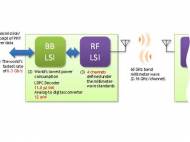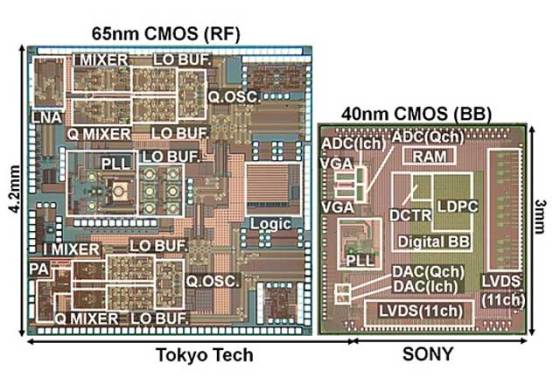Low-power LSIs for wideband millimeter-wave wireless communications at 6.3 Gb/s
 In recent years, enhancements in the multimedia quality increased the demand for wireless communication speeds which lead to increased need for more frequencies, especially for ones bellow 6 GHz band. A joint development from National University Corporation, Tokyo Institute of Technology and Sony resulted with a radio frequency (RF) LSI and a baseband (BB) LSI that enables millimeter-wave wireless data transfer at the new world’s fastest rate of 6.3 Gb/s.
In recent years, enhancements in the multimedia quality increased the demand for wireless communication speeds which lead to increased need for more frequencies, especially for ones bellow 6 GHz band. A joint development from National University Corporation, Tokyo Institute of Technology and Sony resulted with a radio frequency (RF) LSI and a baseband (BB) LSI that enables millimeter-wave wireless data transfer at the new world’s fastest rate of 6.3 Gb/s.
In this joint development, Sony was tasked with designing the digital parts of the BB LSI and the development of the chip unit as a whole, while the Tokyo Institute of Technology designed the RF LSI and the analog parts of BB LSI.
A research team led by Professor Akira Matsuzawa and Associate Professor Kenichi Okada at the Tokyo Institute of Technology has developed an RF LSI that functions as a 60 GHz band millimeter-wave direct-conversion transceiver capable of, for the first time ever, the 16 Quadrature Amplitude Modulation (16QAM) of high-speed wireless communications for every frequency channel defined under the 60 GHz band millimeter-wave wireless communication standards.
This breakthrough has been achieved by a unique back-to-back layout structure of the injection locked oscillator. The analog-to-digital converter (ADC) on the BB LSI achieved the world’s lowest power consumption of 12mW at a sampling rate of 2.3 G samples/s as an ADC integrated in a 60 GHz wireless chip by developing a simple comparator which does not increase the conversion noise.
The high-efficiency and high-integrity of the rate-14/15 Low-Density Parity-Check (LDPC) error-correcting code developed by Sony significantly decreases the amount of redundant data that is required for error correction, and this has enabled LDPC decoding at the world’s lowest per-bit energy efficiency of 11.8 pJ/b (74 mW at 6.3 Gb/s). This LDPC code was proposed to the 60 GHz band millimeter-wave wireless communication standard IEEE 802.15.3c and employed in the standards.
Implementation of this technology will enable users to transmit and receive data at much higher speeds between mobile devices without the need for cable connections. This technology will also enable users to enjoy uncompressed high-quality video streaming from a mobile device to a display.
This technological achievement presented at the International Solid-State Circuits Conference (ISSCC) which is being held in San Francisco in February 19-23, 2012.










Leave your response!